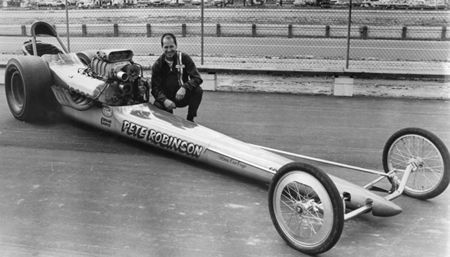|

Back in the good old days of the 60's when I would go to the drags
at four different strips in one weekend in southern California, (Carlsbad
on Wed. night, Irwindale or Fontana on Friday, Lions on Saturday and
San Fernando on Sunday), I had some drag racing "heroes". One of them
was Pete Robinson, from Atlanta, who managed to win the NHRA Nationals
in Indianapolis in 1961 with a blown small block AA/GD Chevy!
I spent some time getting to know Pete at his house in Georgia, along
with his wife Sandra and the baby girl Kelly, and also did a little
road trip with him tire testing in Bristol, Tenn. Because of his different
approach to drag racing, the drag press labeled him as an engineer,
but I don't think he ever earned any college degrees. He tried a number
of revolutionary ideas, most of which almost immediately got banned
by the rules making establishment for being "unsafe".
JUMPING JACKS
One of these wild ideas was "jumping jacks", a simple lever arm that
would allow him to raise the back end of the car off the ground just
as it staged in the lights. This allowed him to let out the clutch before
the tree started to count, pre-rotating the slicks so they were spinning
at whatever RPM he desired when the last yellow came on. He would release
the little lever and the car would drop on the asphalt. Obviously the
tires then has inertia working for them. While this didn't make the
car any quicker, he felt it made him consistently run his quickest possible
time on almost every run. Because a live axle was required to make it
work, the system was banned by NHRA.
At one match race at Lions, Pete was facing Garlits, and although Lions
(Long Beach) wasn't a NHRA track, Don had stipulated that Pete could
not use the jacks as a condition of the match race. The cars push started
down the strip from the big end and made the 180-degree turn to approach
the starting line. Pete stopped 10 feet behind the line, raised the
car onto the jacks, let out the clutch. He calmly reached out of the
driver's seat of his slingshot holding a wire brush in his hand, cleaning
the dirt and pebbles off each slick. He then put the clutch in, stopped
the tires from spinning and staged. Pete said Garlits looked over and
saw what he was doing and got so psyched that Robinson managed to win
the match race with a hole shot 30 seconds later.
VACUUM CLEANER
Another Robinson innovation that could have changed the entire "science"
of drag racing was his vacuum cleaner. Pete was a strong proponent of
light car weight, believing it was easier to accelerate a lighter mass.
He knew if the tires could be made to "think" his car weighed 2,500
pounds, rather than 1150, the tires would have far more traction. The
car would perform better, providing, of course, that he only had to
accelerate 1,300 pounds of car and driver down the track.
After a lot of thought he came up with the "vacuum cleaner" concept.
Attached between the frame rails was a piece of 15-inch wide by 4-foot
long panel of honeycombed aluminum, parallel to the ground, directly
under the engine. Then he fastened rubber "curtains" extending down
from the panel, perpendicular to the track, around its circumference.
They just brushed against the asphalt, making a closed chamber under
the car. Then he built a piece of oval cross section aluminum tubing,
one end of which fit snugly into the mouth of the Enderle injector atop
his blower, extending forward. The tubing then curved down 90 degrees
directly in front of the blower drive, with the other end scaled into
a hole cut in the top of the chamber. Start the motor and you've got
a chamber under the car sucking it down. The whole thing didn't weight
25 pounds.
To regulate the amount of air that was sucked from beneath the car
(since volume of air passing through the motor gets astronomical as
a function of increasing RPM) he put a flapper door in the air tube
between the injectors and the chamber. It had an adjustable spring to
open when the suction beneath the car became too much, admitting air
into the blower from the normal atmosphere without drawing it from beneath
the car.
During private testing he had some sorting out problems. The vacuum
device sucked the car down so hard the rubber curtains were folding
over and dragging against the asphalt. But it worked. As soon as NHRA
heard about it, they banned it. Understand this was months before Roger
Penske and Mark Donahue did the same thing with their Can Am Porshe
that flat ran away from all the other sports cars unitl the SCCA banned
vacuum devices on race cars.
|
|